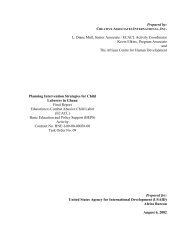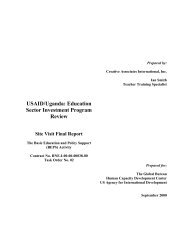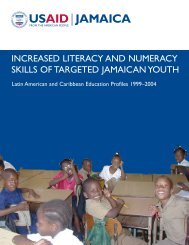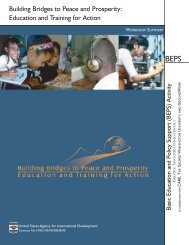Grandmothers: A Learning Institution - Basic Education and Policy ...
Grandmothers: A Learning Institution - Basic Education and Policy ...
Grandmothers: A Learning Institution - Basic Education and Policy ...
- No tags were found...
You also want an ePaper? Increase the reach of your titles
YUMPU automatically turns print PDFs into web optimized ePapers that Google loves.
EXECUTIVE SUMMARYSociety itself fails when it isolates the young <strong>and</strong> the old from one another.Teresa Scott Kincheloe,Native American EducatorThe educational needs of children inAfrica, Asia, Latin America, <strong>and</strong> ThePacific are immense. A major chalgovernments, civil society organilenge forzations, <strong>and</strong> international developmentagencies is to develop strategies to promotethe educational development ofthese children, most of whom live in economicallypoor environments.To address this challenge there has beenconsiderable investment <strong>and</strong> many successesin identifying research-based interventionsto promote children’s educationaldevelopment as part of their overallgrowth. In many cases, however, efforts tointegrate these interventions into family<strong>and</strong> community contexts have not systematicallybuilt on <strong>and</strong> optimized existingroles, values, <strong>and</strong> resources at the locallevel.Since education is an integral aspect ofchildren’s development, this paper examinesexisting evidence regarding the role ofsenior women, referred to in this paper as“gr<strong>and</strong>mothers,” 1 in children’s overalldevelopment, 2 including education, in nonwesternsocieties (in Africa, Asia, LatinAmerica,The Pacific, Aboriginal Australia,<strong>and</strong> Native North America).The paperalso identifies the extent to which policiespromoting the well-being of children supportgr<strong>and</strong>mothers’ inclusion in childdevelopment programming. It highlightsprograms around the world that haveexplicitly involved gr<strong>and</strong>mothers <strong>and</strong>explores in some detail how one of theseprograms was designed to ensure gr<strong>and</strong>mothers’involvement. It concludes byexploring strategies to ensure the involvementof gr<strong>and</strong>mothers in future basic educationinitiatives for children.The review of the literature, policy, <strong>and</strong>programs is framed by several key conceptsthat are not always taken intoaccount in the design of child developmentprograms around the world. Theyinclude: a systems approach; an assetsbasedapproach; cultural roles <strong>and</strong> valuesas a foundation for program design;respect for elders <strong>and</strong> their experience;<strong>and</strong> social capital. The perspective on childdevelopment programming that emergesfrom the combination of these conceptspoints to the need to view gr<strong>and</strong>mothersas key actors in family systems <strong>and</strong> as aninvaluable resource for promoting optimalchild development at that level.1 In this paper, the term “gr<strong>and</strong>mothers” refers to experienced, senior women in the household who are knowledgeable about allmatters related to the health, development <strong>and</strong> well-being of children <strong>and</strong> their mothers. This includes not only maternal <strong>and</strong>paternal gr<strong>and</strong>mothers, but also aunts <strong>and</strong> other older women who act as advisors to younger men <strong>and</strong> women <strong>and</strong> who participatein caring for children.2 Child development, as used throughout this paper, refers to the development <strong>and</strong> continued growth of a child’s emotional, intellectual,<strong>and</strong> physical well-being.GRANDMOTHERS:THE LEARNING INSTITUTIONix







